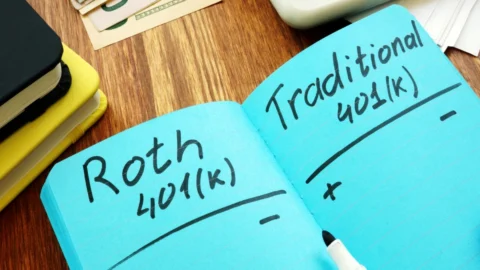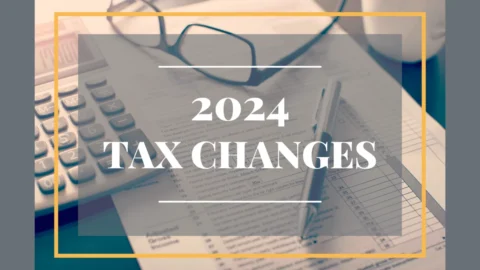TCJA: What to Know Before the Sun Sets
What provisions are expiring and what provisions will be brought back when TCJA sunsets after 2025
The Tax Cuts and Jobs Act (TCJA) was passed back in December of 2017. It brought about substantial changes to the tax code such as lowering tax rates, increasing standard deductions, and raising the lifetime gift tax exclusion limits. TCJA also removed some very popular tax deductions such as the deductibility of entertainment expenses for businesses and limiting or removing popular itemized deductions.
In total, there are 23 provisions from the TCJA related to individual taxes that are set to expire on December 31, 2025 unless extended via legislation. Below we will discuss the majority of the expiring provisions and what the changes could mean for your tax return. While this piece will not cover all potential changes, the provisions we are not discussing are very niche in nature and only impact a very small number of taxpayers.
Tax Brackets
Prior to the TCJA, the federal marginal tax brackets were 10%/15%/25%/28%/33%/35%/39.6%. Under TCJA these brackets were reduced to 10%/12%/22%/24%/32%/35%/37%.
These lower brackets allowed some individuals to see lower tax bills and higher tax refunds. Certain high-income individuals actually saw increased tax bills under TCJA due to the elimination of certain deductions.
Again, these tax brackets will be reverting to the pre-TCJA brackets after 2025 without new legislation. TCJA did not affect the capital gains tax rates and therefore those will remain the same after 2025. This means that there is a potentially closing window for people to take advantage of these lower tax rates through tax planning techniques such as Roth conversions, income shifting, and capital gains harvesting.
Standard & Itemized deductions
There are a number of provisions related to standard and itemized deductions that could sunset in 2025.
Standard Deductions
TCJA doubled what the standard deduction was at the time of its passing. This helped many young and lower income taxpayers reduce their tax bills, as they did not have enough items to itemize previously. Starting in 2026 the standard deduction will revert to half of the current amount. This will cause some taxpayers to have higher tax bills and create the need once again keep up with the various expenses that can be used towards the itemized deduction.
Limitation to State and Local Tax deduction
People who lived in states with higher state and local tax previously received federal tax relief for paying high SALT (State And Local Tax) taxes through an unlimited itemized deduction. The TCJA put a limit on this deduction of $10,000 that was not eligible to be indexed for inflation. This left many taxpayers, especially in states with high SALT taxes, limited post-TCJA to the standard deduction, since this was a significant itemization previously.
After 2025 this limitation will be removed, and taxpayers will once again be able to fully deduct SALT taxes on their tax returns if they itemize their deductions. It is important to note that this deduction is a hotly debated tax topic, and the limitation might be increased or removed even prior to the sunset deadline in 2025.
Medical Expense AGI Floor lowered
TCJA lowered the Adjusted Gross Income (AGI) floor that was applied to medical expenses taken as itemized deductions from 10% to 7.5%. This change helped many taxpayers, especially those in retirement, claim more itemized deductions over the past couple of years due to medical expenses.
Charitable Contribution AGI Limitation
Under TCJA, the AGI limit for how much could be donated to charities and deducted through itemized deductions was increased from 50% to 60% of a taxpayer’s AGI. The AGI rules limiting the number of appreciated securities that could be donated to charities were unchanged by TCJA. After 2025, the AGI percentage will decrease once again to 50% of the taxpayer’s total AGI.
Deductibility of Qualified residence interest
Interest payments on up to $1.1m of debt including up to $100,000 of home equity debt was previously eligible for the interest paid deduction when claiming itemized deductions. TCJA limited this to only allow the interest paid deduction for interest payments on up to $750,000 on new debt between the principal residence and one other residence. Starting in 2026, this limitation will revert back to the pre-TCJA numbers and allow more interest paid as a deduction for taxpayers.
Miscellaneous Itemized Deductions
A very common itemized deduction that used to be taken prior to TCJA was the miscellaneous itemized deduction. TCJA completely removed this itemized deduction, but it will be reinstated after 2025. All miscellaneous itemized deductions will be subject to a 2% AGI floor. Some expenses that fall into this category are unreimbursed employment expenses, investment expenses such as management fees and trustee fees, tax preparation fees, hobby expenses (up to hobby income), and fees related to fighting the IRS.
Itemized Deduction limitation
TCJA suspended the itemized deduction limitation that was in effect prior to its passing. Prior to TCJA, single individuals had an itemized deduction limitation of $261,500, Head of Household of $287,650, MFS of $156,900 and MFJ of $313,800. Starting in 2026 these limitations, adjusted for inflation, will return.
Other Common Deductions
Along with those listed above, there are other common deductions that will be effected in 2025 if left unchanged.
Qualified Business Income Deduction (QBI)
One of the more beneficial deductions that came from TCJA was the QBI deduction. This allowed taxpayers to deduct up to 20% of business income from flow-through entities, such as Schedule C businesses, S-Corps, and Partnerships, on their 1040. This deduction was originally intended to allow other business structures to compete with the new 21% tax rate of C-Corporations.
While there has been buzz around this tax deduction possibly being extended, nothing has been passed yet. Under the current regulations this deduction will be completely removed after 2025. This has the potential to hurt many flow-through entities and cause more businesses to elect to be taxed as a C-Corporation.
Personal Exemptions Return
One of the most common tax deductions previously allowed on tax returns was personal and dependent tax exemptions. Prior to TCJA, this allowed taxpayers who had an AGI lower than $156,900 to take a $4,050 deduction for the taxpayer, their spouse, their dependent children as well as other non-child dependents.
The exemption deduction system was thrown out under TCJA as it was believed the increased standard deduction would be enough to cover deductions created by the exemptions. With the sunset of TCJA and the standard deduction being cut in half after 2025, this exemption system will return. This could have varying effects based on a taxpayer’s income and number of dependents. Higher earning taxpayers could see an increase in taxes with this reversion while taxpayers with many dependents could see some benefit under the old exemption system.
Personal Casualty Loss Deduction
Prior to the passing of TCJA, unreimbursed personal casualty losses could be included in taxpayer’s itemized deductions. These losses were subject to a 10% tax floor and would be reduced by $100 per event.
There were also special rules related to federally declared disaster areas that allowed taxpayers to deduct any unreimbursed personal casualty loss due to a federal disaster. This special rule stated that taxpayers within a federally declared disaster area could deduct their casualty losses even if they do not itemize their deductions and that the 10% AGI floor did not apply to these types of losses. These expenses were also required to be reduced by $500 when calculating the disaster loss.
Under TCJA, taxpayers were limited to only being allowed to claim a personal casualty loss deduction if they were in a federally declared disaster area. After 2025 this limitation will be removed, and taxpayers will once again be allowed to claim a deduction for personal casualty losses even if they are not related to a federally declared disaster area.
Moving Expense
TCJA impacted moving expenses incurred by employees in two different ways. First, it made reimbursed moving expenses taxable to the employees where prior to TCJA they were not taxable to the employee. Secondly, TCJA disallowed employees to take a deduction on their tax return for unreimbursed moving expenses (except for those in the US armed forces).
After 2025 both of these provisions will be reversed to the benefit of the taxpayer. This means that after 2025, employees that are forced to move for work will not have to pay taxes on reimbursed expenses from their employer and will be able to take a tax deduction for unreimbursed expenses.
Other Important Items
There are some other important changes that could take place in 2025. We list out a few of these items below.
Estate Tax Lifetime Giving Limit
One major change under TCJA was the increase of the lifetime gift exclusion limit from roughly $6 Million per person to $12 million per person. This exclusion limit applied to high-net-worth individuals who are looking to transfer wealth to the next generation. This exemption may be used while a taxpayer is alive to give gifts to individuals over the annual gift tax limit or when the taxpayer dies and their estate is being distributed.
People who had previously reached their $6 million dollar limit prior to TCJA were eligible to pass $6 million more due to the increase, but people who use the entire $12 million prior to 2025 will not be penalized once this provision sunsets and is reduced by half. This means that it is more important than ever if you have a large taxable estate to consider the disposition of your assets prior to 2025 to take advantage of this larger lifetime exemption amount before expiration.
Child Tax Credit
Under TCJA the child tax credit amount was increased from $1,000 to $2,000 and allowed a $500 deduction for other dependents. It also increased the income phase out for these credits and the refundable portion of this credit. After 2025 this credit is set to go back down to $1,000 and significantly decrease the income threshold where the phase out on this credit kicks in. This is another item that many politicians are looking at reinstating or extending instead of letting it expire.
Meals and Entertainment Deductions
Businesses have faced substantial confusion around how TCJA affected the meals and entertainment deductions. This is primarily due to COVID and the temporary changes that were made to help the food and restaurant industry. TCJA fully removed the ability to deduct entertainment expenses and, unfortunately, is not set to return after sunset in 2025. Several other meal related expenses were cut in half due to TCJA and will be fully eliminated after 2025.
Bonus Depreciation
Bonus Depreciation is a very beneficial tax deduction that allows businesses to accelerate their depreciation on qualified property. Between 2018 and 2022 businesses were allowed to take 100% bonus depreciation in the year the qualified property was acquired.
Unlike the other provision changes in the TCJA, Bonus depreciation sunsets over multiple years. In 2023 bonus depreciation of 80% is allowed, 60% in 2024, 40% in 2025, 20% in 2026, and is fully expired in 2027. While taxpayers are still allowed to take accelerated depreciation on certain qualified property under Section 179, it would be wise for taxpayers to take advantage of bonus depreciation before it is fully phased out in 2027.
AMT Exemption and Phase Out
Under TCJA the exemption amount and phase out range to have the Alternative Minimum Tax (AMT) apply to taxpayers were increased. This means that less people had to worry about and pay AMT under the TCJA. This is going way after 2025 which will subject some additional taxpayers to the AMT. Having large tax-exempt bond interest or a large state and local tax deduction can cause a taxpayer to be at a higher risk of owing AMT.
What TCJA Items are Here to Stay
While the above items are expected to sunset in the future, there are a couple of tax provisions created by TCJA that are here to stay and will not expire.
Corporate Tax Rate of 21%
For C-Corporations the TCJA brought about one of the most impactful changes in years. This was changing the corporate tax rate from a flat 35% to a flat 21%.
This change was made to encourage companies to bring jobs, operations, and money back into the US and align the US corporate tax policy to align more with the average international corporate tax rates of around 23%. While the TCJA made this tax rate change permanent, regulators have already thrown out the idea of increasing it in the future in order to make up budget and spending deficits.
Inflation Indexing on tax brackets and credits
The TCJA changed how the tax brackets and certain tax credits were increased due to inflation. The IRS previously used the Consumer Price Index for all Urban Consumers (CPI-U) but made the change to the chained CPI-U.
While this does not seem like a large change, it will make an impact in the year-over-year adjustments to these items. The chained CPI-U generally increases at a slower rate than the traditional CPI-U which means that tax brackets and tax credits will be increased more slowly than they would have under the previous system.
Affordable Care Act Penalty Tax
The TCJA removed the tax penalty for not having health insurance that was created under the Affordable Care Act. This penalty removal was a permanent change and is put in place so that people are not penalized if they choose to self-insure and not pay for health insurance coverage.
It is important to note that we have only touched on tax provision changes brought about by TCJA. There have been other significant changes to the tax code under the Secure Act as well as the Secure Act 2.0. If you would like to read more about these changes, please read our separate articles covering those topics.
If you would like to discuss the TCJA sunset rules and how they might affect your specific financial situation, please feel free to contact us at Rhame & Gorrell Wealth Management for a complimentary consultation.
Need Some Help?
If you’d like some help from one of our CPAs or CERTIFIED FINANCIAL PLANNER (CFP®) advisors regarding this strategy and how it applies to you, the Rhame & Gorrell Wealth Management team is here to help.
Our experienced Wealth Managers facilitate our entire suite of services including financial planning, investment management, tax optimization, estate planning, and more to our valued clients.
Feel free to contact us at (832) 789-1100, [email protected], or click the button below to schedule your complimentary consultation today.
IMPORTANT DISCLOSURES:
Corporate benefits may change at any point in time. Be sure to consult with human resources and review Summary Plan Description(s) before implementing any strategy discussed herein.Rhame & Gorrell Wealth Management, LLC (“RGWM”) is an SEC registered investment adviser with its principal place of business in the State of Texas. Registration as an investment adviser is not an endorsement by securities regulators and does not imply that RGWM has attained a certain level of skill, training, or ability. This material has been prepared for informational purposes only, and is not intended to provide, and should not be relied on for, tax, legal or accounting advice. You should consult your own CPA or tax professional before engaging in any transaction. The effectiveness of any of the strategies described will depend on your individual situation and should not be construed as personalized investment advice. Past performance may not be indicative of future results and does not guarantee future positive returns.
For additional information about RGWM, including fees and services, send for our Firm Disclosure Brochures as set forth on Form ADV Part 2A and Part 3 by contacting the Firm directly. You can also access our Firm Brochures at www.adviserinfo.sec.gov. Please read the disclosure brochures carefully before you invest or send money.














